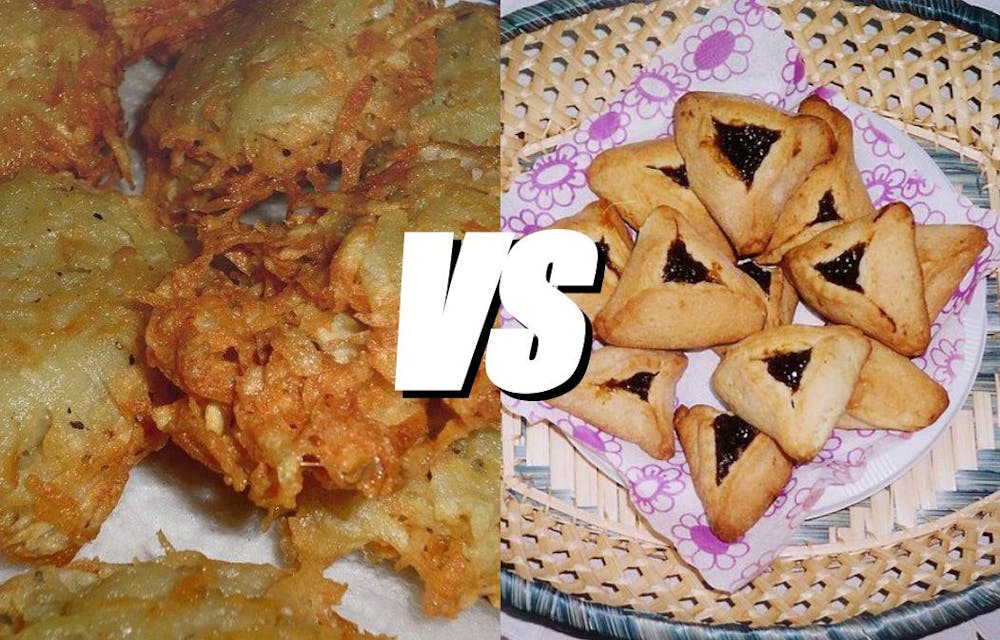The Hillel Student Board (HSB) of the Jewish Students Association held “The Great Latke-Hamantaschen Debate” on Dec. 9. The debate featured Dean of the Whiting School of Engineering Ed Schlesinger, along with professors Steven David, Jonathan Flombaum, Yitzhak Melamed and Anne Eakin Moss.
HSB Shabbat Chair Rosie Wolkind explained that the debate centered around the significance of latkes and hamantaschen in Jewish history. Fried potato latkes are eaten on Hanukkah, whereas hamantaschen are triangle-shaped cookies typically filled with either jelly or chocolate that are eaten on Purim.
Wolkind noted that both holidays celebrate the survival of the Jewish people.
“It’s a pretty common theme in our history,” she said. “As every Jewish grandpa loves to say, ‘They tried to kill us, let us eat!’”
Panelists took turns arguing for their food of choice, applying concepts from their respective fields of study.
Team Latke included Melamed, who made the case that hamantaschen are geometrically impossible.
In an email to The News-Letter, senior Liza Goldstone explained that Melamed’s presentation was the highlight of her night.
“Professor Melamed conducted a proof to prove that triangles do not exist, and therefore hamentashen cannot exist either,” Goldstone wrote. “That was just so insane, but really entertaining.”
David also debated on behalf of the latke, applying concepts from his course on Sino-American relations, which he will teach this spring.
According to David, latkes have both the hard and soft power necessary to combat China.
“The American people must find a new way forward to advance American interests and defeat a rising China,” he said. “From now on, it is latke first, down with hamantaschen and God bless America.”
In an email to The News-Letter, junior Lance Kotler cited David’s presentation in explaining why he switched from Team Hamantaschen to Team Latke.
“Professor David was exceptional, and then there were additional reasons why hamantaschen were geometrically impossible to go along with it,” he wrote.
Flombaum, who had participated in this debate in previous years, argued on behalf of Team Hamantaschen. He explained that his support for the latke in 2010 was naive and misguided.
“I was wide-eyed, optimistic, thin, healthy looking, [and] had one child,” he said.
Junior and HSB Marketing Chair Alanna Margulies, who helped organize the event, wrote in an email to The News-Letter that Flombaum gave her favorite presentation of the night.
“If you listen back to the video, you may or may not be able to hear me laughing in the background of his presentation before I realized that my microphone was on,” she wrote.
Schlesinger argued that the debate poses a false dichotomy.
“The latke and the hamantaschen together represent the entirety of creation at cosmic dimensions, quantum mechanical dimensions and in the spiritual realm,” he said. “Eat both, eat often, ignore the calories.”
Eakin Moss was the dark horse of the event, arguing on behalf of neither of the two foods but instead a type of small dumpling.
“I am here today not to take sides in this acrimonious debate among my esteemed colleagues, but to present to you a compromise candidate that is clearly vastly superior to the humble latke or the fancy pants hamantaschen,” she said. “The kreplach.”
Noting that most of the Russian writers she studied and taught were anti-Semitic, Eakin Moss was also the only panelist to base her arguments outside her field of study.
Rather than give a presentation, she chose to feature a video.
“As the token woman on the panel... I decided I would unironically perform my heteronormative gender role and Ashkenazinormative Jewishness and offer you an irresistibly cute cooking video featuring my Yiddish-speaking 6-year-old daughter,” Moss said.
In an email to The News-Letter, HSB President Beckie Cohen reported that she was pleased with how the event turned out.
“It was a nice study break, but more than that it was a nice opportunity to interact with professors across the University and engage with other students in the YouTube chat,” she wrote.
Margulies agreed with Cohen.
“There was a lot of uncertainty about the technology and just a lot of effort that everyone involved put in over the days and weeks leading up to the event, and at the end, I could say with confidence that we put out a product that we could be proud of,” she wrote. “Hopefully this will become a yearly event.”
Margulies and Cohen both credited junior and HSB Learning Chair Jake Lefkovitz with the idea behind the event.
According to Lefkovitz, the event was a success.
“It’s important because it’s an excuse for people to cut back and let themselves loose a little during what is a very stressful time,” he wrote in an email to The News-Letter. “It’s important to laugh, and I think that this year’s debate was side-splitting.”
Margulies agreed that the timing of the event worked well.
“It seemed like a great way to bring people together in a stress-free environment right before finals in a way that took people out of the COVID, stressful reality we’re living in and remind ourselves what we all love about the Hopkins Jewish community and Hopkins as a whole,” she wrote.
The winner was decided based on crowd donations to the First Nations Development Institute, of which Team Latke collected more. In total, the event raised $335.60.
Jake Lefkovitz is a staff writer for The News-Letter, and Alanna Margulies is a contributing writer. Neither contributed reporting, writing or editing to this article.





